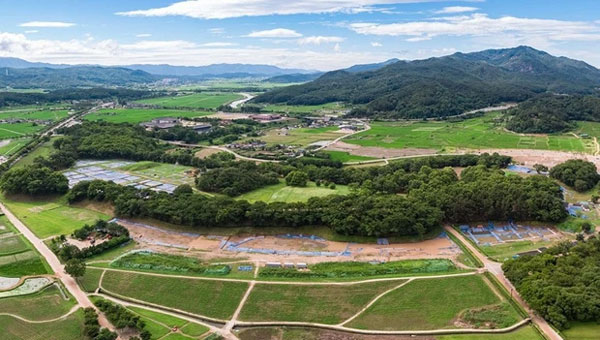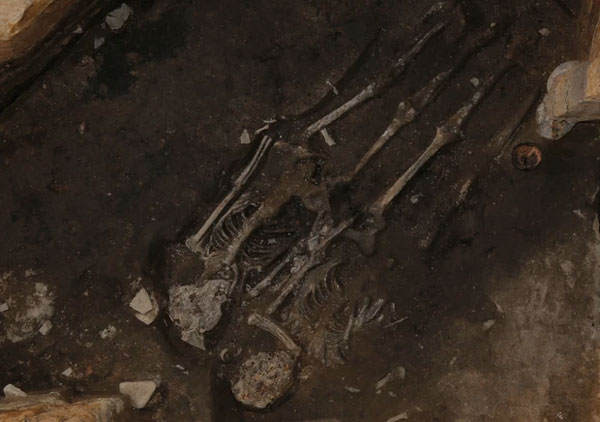The set of remains reveals the horrifying secret at the foot of the wall of Korea's 'Moon Palace'
Around AD 50, after more than 100 years of establishment, the House of Silla decided to build the capital. They chose Gyeongju, a coastal land in the southeastern part of present-day Gyeongsang, to base the first palace: Wolseong.
Wolseong embraces the hill with the terrain like a semi-circle, similar to the crescent moon, so it is called the Moon Palace.
Excavating a short section of the wall, discovered 3 skeletons
According to the records of Korean history, the Silla Dynasty lasted for 992 years, starting in 57 BC and ending in 935. During these nearly 1000 years, they stationed their capital in Gyeongju and the Silla kings passed during this period. Moon Palace.

Moon Palace ruins, Korea.
When the Silla Dynasty fell, successive dynasties abandoned Gyeongju. Today, the 1000-year-old capital Silla is just a relic. Although many buildings have disappeared, it still has most of its traces, and was recognized as a world cultural heritage site by UNESCO in 2000.
Since the second half of the twentieth century, Gyeongju has been an archaeological hotspot. In the 1980s, Korea focused on excavating the Moon Palace. They discovered several human and animal bones scattered everywhere. The researchers speculated, these are just remains of natural death.
In 2017, South Korea excavated a section of the wall surrounding the palace. It is about 36m long and 9.1m high. Suddenly, at the foot of this section of the wall, two skeletons were found side by side. They belong to a man and a woman in their 50s, suspected to be husband and wife.

The remains of a peasant couple, discovered at the foot of the wall of the Moon Palace.
In 2021, Korea continues to discover another skeleton. It is located just a few meters away from two skeletons found in 2017 that are the remains of a young woman.
Kill the sacrifice, bury in the foundation of the wall
The history of feudal Korea does not have any record of human sacrifice. Folklore also only transmits half-false and half-true stories that aristocrats killed slaves and buried them in tombs as slaves.
After the discovery in 2017, South Korea carefully examined the two skeletons of the suspect, and found no signs of injury before death. At the place of these two people, there are only a few broken pieces of pottery, analysis of bones and teeth shows signs of nutritional deficiency. Archaeologists conclude that this is a poor peasant couple, likely the sacrificial victims.
The 2021 finding reinforces the above speculation. In addition to their close proximity, analysis of the bones and teeth of the girl's remains also indicated that she was malnourished during her lifetime. "I guess all three of them were poor ancient inhabitants of the lowest class of Silla society," said Jang Ki Myeong, an archaeologist at the Gyeongju National Institute.

The young girl's remains, located just a few steps away from the peasant couple.
Carefully inspecting the location where 3 skeletons were discovered, Korea found traces of intentional burial. It seems that the builders of the Silla period left 2 gaps in the foundation of this wall, one just enough to fit the bodies of an elderly farmer couple, and one just enough to place a young girl. Most likely, the ritual sacrifice was held on the day of laying the foundation. The above three victims were killed at the same time, arranged in a prepared position. After filling the gap, people finished the foundation and went up to the wall, burying the bodies under the towering wall.
Despite the desire for stability
Back when the Silla Dynasty established the imperial capital, Korea was in the Three Kingdoms Period. In addition to them, this peninsula has two great powers: Baekje (the southwestern language) and Koguryo (covering the north and part of China). The three of them continuously intruded on the border and invaded each other continuously.
The Moon Palace was not only the residence of the Silla kings, but also acted as a representative of the dynasty. Its solidity symbolizes the stability of the dynasty. "For the sake of a secure and eternal future, the rulers defied and fulfilled all promises to protect the palace," - Jack Davey (USA), an archaeologist at George Washington University, confirmed.
"The massive wall construction and human sacrifice show how insecure and threatened the Silla kings were," added Davey. "It lasted for hundreds of years, until they unified Korea (668-935)."
The wall of the Palace of the Moon was started around 400 AD, divided into several stages. This was a time of many upheavals and wars, putting heavy pressure on the Silla kings. Although North Korea does not have a superstition of sacrificing castle builders, it has probably been heard from China. They do it secretly and do not record or transmit it.
It took about 600 years for the construction of the Gyeongju Capital to be completed. From the 7th – 10th centuries, it was continuously the center of the Silla Kingdom. "Even without the discovery of the sacrificial event, Gyeongju is still an important archaeological site," said Davey. At least, this place still has over 7000 cultural relics, ranging from tombs and temples to countless antiques, detailing the history of the Silla Dynasty.
- The erosion coast reveals six remains hundreds of years old
- Chinese students live 200 days in 'Moon home'
- Revealing the secret half-moon of the Moon
- Historical moments when people first set foot on the Moon
- The last person set foot on the Moon
- Settling on 'Moon Palace' will no longer be a distant dream
- Discover the palace of Kublai Khan under the Forbidden City
- July 20: Celebrating 47 years of the first time people set foot on the Moon
- Official: Americans will return to the Moon
- NASA for the first time revealed the secret
- Admire the 10 most magnificent palaces in the world
- Marvel at the accuracy of prophecies
 Discovered an ancient centipede fossil 99 million years old
Discovered an ancient centipede fossil 99 million years old Discovered bat-like dinosaurs in China
Discovered bat-like dinosaurs in China Discovered a 200-year-old bronze cannon of the coast
Discovered a 200-year-old bronze cannon of the coast Discover 305 million-year-old spider fossils
Discover 305 million-year-old spider fossils